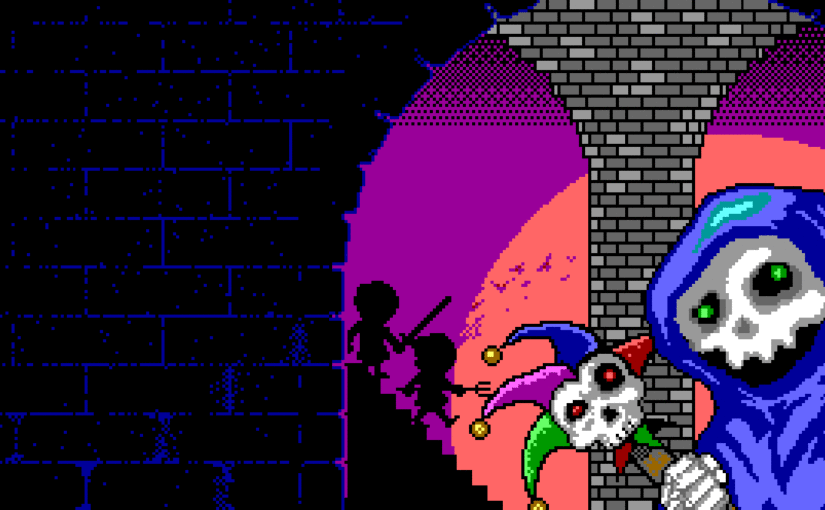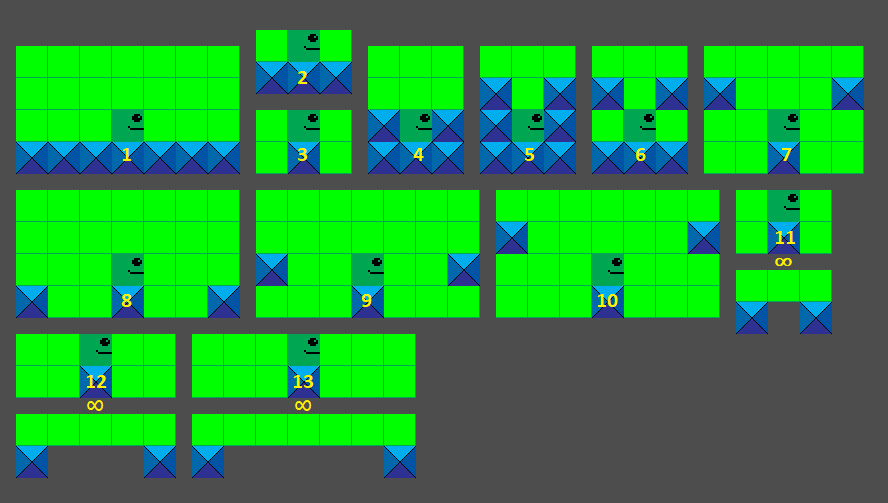Naively Ambitious
Beaster’s Dungeon was to be a 2D platformer where the player would try to stop oncoming hoards of enemies from reaching your treasure vault by collecting resources to build and place elaborate traps.
It was conceived by my friend Eric and myself in late November of 2016. We sketched out a rough outline and slowly refined it into a proper (read: laughably inadequate) design document by early December.
Progress was slow as Eric and I both had very steep learning curves to overcome. I (arguably) had the easier job of creating the artwork and animation, and had plenty of references to lean on for inspiration. Eric, on the other hand, had the dubious honor of trying to cobble together code from various YouTube tutorials and the results were about what you’d expect.
We were getting nowhere fast, and even what [naively] seemed to me to be the simplest features were a puzzle of Gordian complexity for which I decided to apply the Alexandrian solution: cut it all loose and start anew.
Somehow, I stumbled across John Janetka’s Game Programming Course, and by the third lesson, knew enough about GML to solve many of the programming problems Eric was stuck on. Encouraged by a possible way forward, I suggested to Eric that we complete the coursework together. For Eric, this would serve to build the foundational knowledge and concepts he needed to master in order to get predictable, repeatable results. For me, well partly as a show of solidarity and encouragement, but mostly so that I could help troubleshoot when he got stuck.
Eric [reluctantly] agreed and we set off – what follows are details I haven’t really shared before, but I will try to present them objectively in the hope that someone, somewhere will learn from them.
Sullenly Inevitable
Over the next few weeks, I dove head first into the well of knowledge, occasionally coming back up to share what I’d learned on this blog. Eric was less enthusiastic about this, seeing it as a chore, but went through the motions – at least for a while.
To me, each lesson represented one step closer to accomplishing my goals. To Eric, each assignment was a step backward, taking us further and further away from a completed project.
Toward the end of January, I was eager to test what I’d learned by making a simple game from start to finish – that game was Porker: The Quest for Tastiness, more on that below. Eric on the other hand was thoroughly demoralized, having completely given on up on the GPC, and would soon after withdraw himself from the project altogether. What went wrong?
Rowing in the Same Direction
“Much like a relationship, I don’t think a game development team works if the designers aren’t on an equal ability and similar mindset”
– ‘3kliks’ Philip Dyer
From the beginning, I recognized that if I wanted to develop games, I would need to develop my skill set which, as I often lamented, was lacking. But I worked on it and improved, little by little.
As an individual hobbyist, you can work at your own pace, are accountable to no one but yourself and your project(s) can drag on for months or even years on end. You can pick up where you left off, start over or let it collect dust in the dark recesses of a forgotten folder.
In a team of unpaid amateurs, some are genuinely passionate and are prepared to commit time, money and resources to realize their shared dream. Others are only along for the ride, hoping to be carried across the finish line. Somewhere in the middle are those who start strong, but lose steam quickly and eventually drop out.
This could be due to:
- Change in personal circumstances
- Distractions
- Lack of commitment
- Loss of interest
- Discouragement
- Unrealistic expectations
- Disagreements and disputes…
In part 7 of his YouTube series called “The Game Making Journey,” Philip Dyer (AKA 3kliksphilip) begins by stating that, “Game design has a reputation for being a boring and lonely activity (probably), but it doesn’t have to be this way! Making them with other people is an exciting bonding experience that almost always ends in disaster. Much like a relationship, I don’t think a game development team works if the designers aren’t on an equal ability and similar mindset.”
For Eric and I, there was a disconnect. When I committed to working on the project, I threw everything I had into it. Between working sessions, I read everything I could get my hands on related to the subject from game design theory to level design concepts to lessons learned from other indie game developers, and tried to incorporate this into my thinking.
Eric wasn’t really interested in what the outside world did or thought, and to my knowledge, never actively sought information or did research. Perhaps he was afraid his ideas would be polluted by outside influences and lose their originality, or perhaps he was afraid that doing so would somehow detract from the magic of it.
A Kind of Magic
To him, creating videos games was a kind of magic – you simply needed to learn the incantation, wave your arms about and the computer would either reward you with your desired outcome or punish you for your insolence by refusing to work, or worse yet, play a trick on you and give you something you didn’t expect.
“One dream, one soul, one prize, one goal
One golden glance of what should be
It’s a kind of magic” – Queen, It’s a Kind of Magic
Having spent the last 20 years of my life (and career) working with computers, I knew this couldn’t be further from the truth. If something didn’t work right, it was my fault for not understanding the syntax or behavior – garbage in, garbage out! The computer had no will of its own, and had no choice but to interpret the commands I gave it in the order they were received, and the order of things mattered.
Larger problems are broken up into smaller problems, and smaller problems can be solved, provided they’re well-defined – no room for ambiguity here!
Never Say Never!
By February 1, 2017, I’d completed the GPC. I wasted no time and dove into re-coding Beaster’s Dungeon. By this point, Eric had stepped down from coding and wanted to try his hand at game design. I created a Game Design Document (GDD) template for him and set him to work while I tried to build a prototype.
By the end of the first week, basic movement was finished, and I was struggling with the trap placement mechanic. I had no idea how build this, and had to take a step back.
Despite all of the effort I put forward insofar as music, graphics and now code, I still wasn’t a “Game Developer” because I had not yet produced “a Game.” This bothered me a lot.
I was discussing this with my friend, Jim, and while talking about GMS, I pulled it up in Google Hangouts and started showing him things. He was drunk, and we were having a great time – he’d shout out silly ideas to me while I coded the game. The artwork was mostly modified from open-source images found here and there. Still, it had that late 90’s flash game charm and worked well enough – it didn’t have to be a great game, but I did have to finish it, and after two days of work, the result was, “Porker: The Quest for Tastiness”, which we released under Jim’s website, porkcircus.com.
###
I never did get back to Beaster’s Dungeon – forever confounded by that damned trap mechanic – until yesterday!
To be continued…



